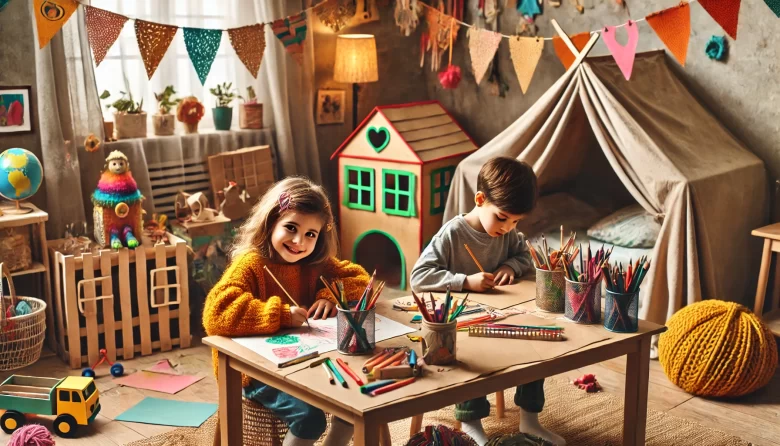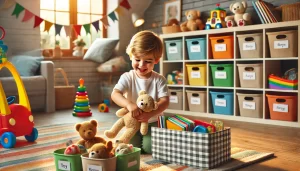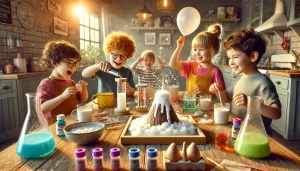Children between the ages of 2 and 5 are naturally curious and eager to learn. At this stage, play is the most effective way for them to develop cognitive, motor, and social skills. Educational games help improve memory, problem-solving abilities, language skills, and creativity while making learning fun.
You don’t need expensive toys to keep your child engaged—many activities can be done using everyday household materials. Below, you’ll find easy and creative educational games tailored to different learning areas.
Color Hunt Game
Best for: Color recognition and observation skills
Materials Needed:
- Colored paper or fabric pieces
- Small objects in various colors
How to Play:
- Place different colored paper or fabric around the room.
- Give your child a small object and ask them to match it to the correct color.
- Encourage them to name the colors aloud.
This simple activity helps toddlers recognize colors while improving their ability to observe and categorize objects.
Sorting and Counting with Everyday Objects
Best for: Early math skills and fine motor coordination
Materials Needed:
- Buttons, beads, or small toys
- Cups or bowls
- A marker to label numbers
How to Play:
- Label each cup with a number (e.g., 1, 2, 3, etc.).
- Ask your child to place the correct number of objects in each cup.
- For younger toddlers, simply sorting objects by color or size is a great alternative.
This activity introduces basic counting and strengthens fine motor skills.
Mystery Texture Box
Best for: Sensory development and language skills
Materials Needed:
- A box or bag
- Objects with different textures (soft, rough, bumpy, smooth, etc.)
How to Play:
- Place different objects inside a box.
- Have your child reach in, feel an item, and describe its texture without looking.
- Encourage them to guess what the object is before taking it out.
This sensory game helps with vocabulary development and enhances their ability to describe sensations.
DIY Alphabet Puzzle
Best for: Letter recognition and early literacy skills
Materials Needed:
- Cardboard
- A marker
- Scissors
How to Play:
- Cut out 26 small cardboard squares.
- Write uppercase letters on one set and lowercase letters on another.
- Have your child match the uppercase letters with their lowercase counterparts.
This hands-on puzzle helps children recognize letters and prepares them for reading.
Shape Jumping Game
Best for: Gross motor skills and shape recognition
Materials Needed:
- Large pieces of colored paper
- A marker to draw shapes
How to Play:
- Draw different shapes (circle, square, triangle, etc.) on large pieces of paper and place them on the floor.
- Call out a shape, and your child must jump to it.
- Add an extra challenge by calling out colors along with shapes (e.g., “Jump to the blue triangle”).
This game promotes physical activity while reinforcing shape and color recognition.
Sound Matching with Homemade Instruments
Best for: Auditory discrimination and musical creativity
Materials Needed:
- Plastic bottles, rice, beans, or pasta
- A box or small containers
How to Play:
- Fill plastic bottles with different materials (e.g., rice, pasta, small bells) to create different sounds.
- Shake one and ask your child to find the matching sound by listening carefully.
- You can also create a rhythm pattern and have them repeat it.
This activity sharpens listening skills and introduces early music concepts.
Build a Tower Challenge
Best for: Problem-solving and fine motor development
Materials Needed:
- Blocks, cups, or boxes
How to Play:
- Challenge your child to build the tallest tower possible.
- Encourage them to experiment with different stacking techniques.
- Talk about balance, height, and structure as they build.
This game improves hand-eye coordination, patience, and problem-solving skills.
Animal Sounds Guessing Game
Best for: Language development and memory skills
Materials Needed:
- Picture cards of animals (or a book with animal images)
- Your voice or an audio recording of animal sounds
How to Play:
- Play an animal sound and ask your child to guess which animal it is.
- Show them the corresponding animal picture and say the name of the animal.
- Ask them to imitate the sound.
This fun game strengthens memory and helps children associate sounds with objects.
Shadow Puppet Play
Best for: Creativity and storytelling skills
Materials Needed:
- A flashlight
- Paper cutouts or hands for shadow shapes
How to Play:
- Dim the lights and shine a flashlight on a blank wall.
- Use your hands or paper cutouts to create shadow animals.
- Encourage your child to invent a story about the shadows.
This activity fosters imagination, storytelling skills, and communication.
Hide and Seek with Toys
Best for: Problem-solving and observation skills
Materials Needed:
- Small toys or stuffed animals
How to Play:
- Hide a toy somewhere in the room.
- Give your child clues or warmer/colder hints to help them find it.
- Once they find the toy, let them hide it and give you clues.
This game improves critical thinking and teaches children how to follow directions.
Final Thoughts
Educational games play a vital role in childhood development, helping children build essential skills while having fun. The best part? Many of these activities use materials you already have at home. By incorporating learning through play, you can make education enjoyable and engaging for your child every day.




